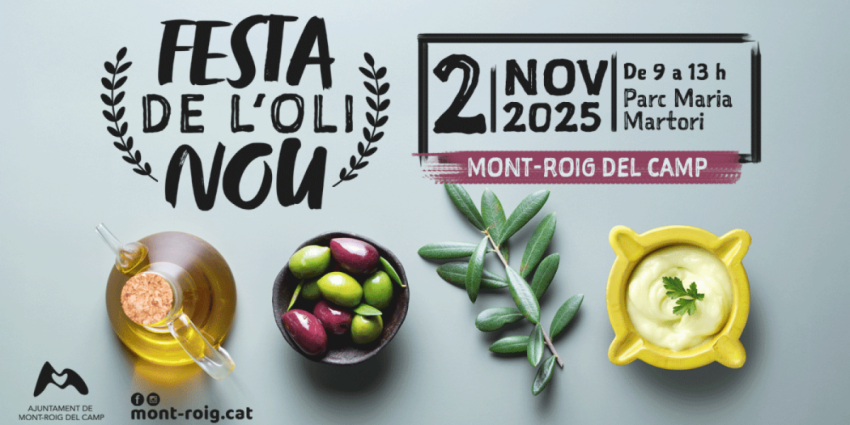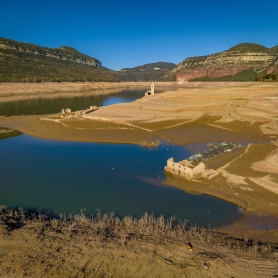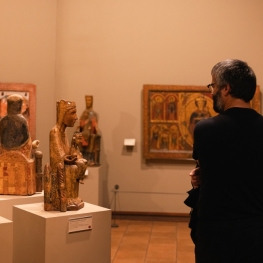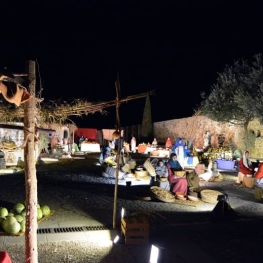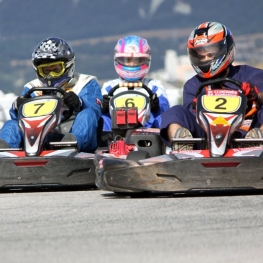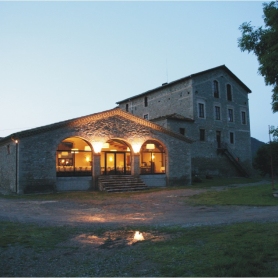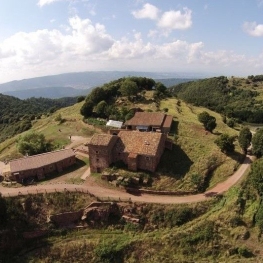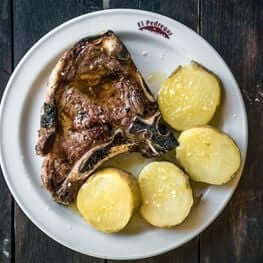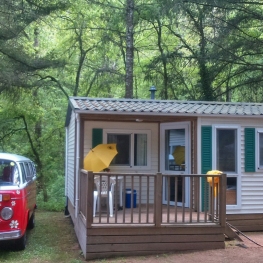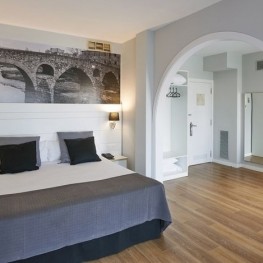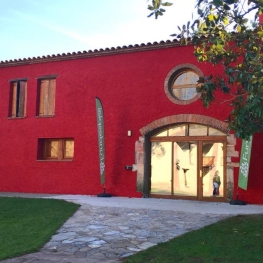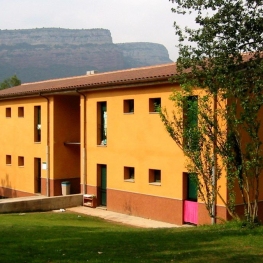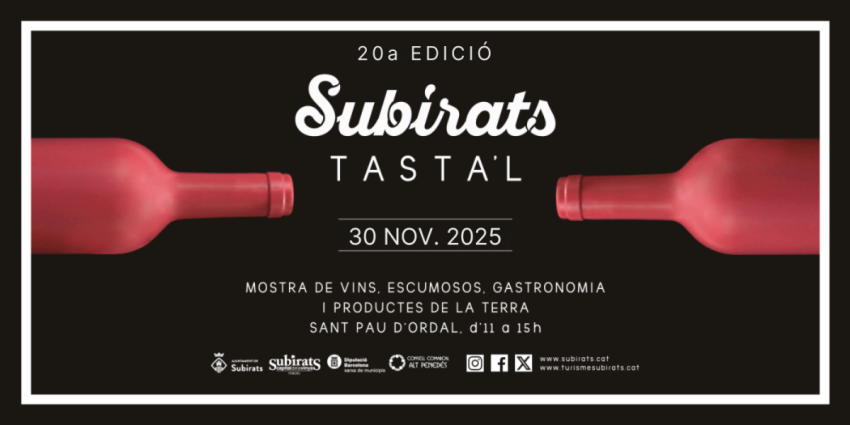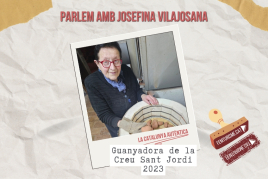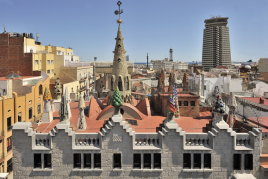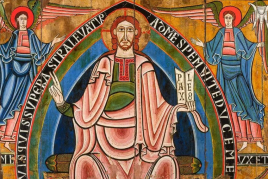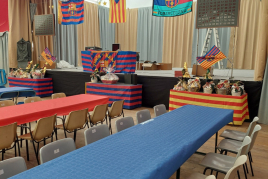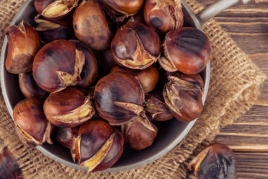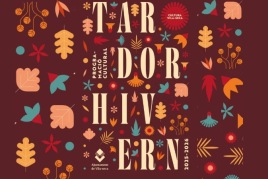Route through the historic center of Vic
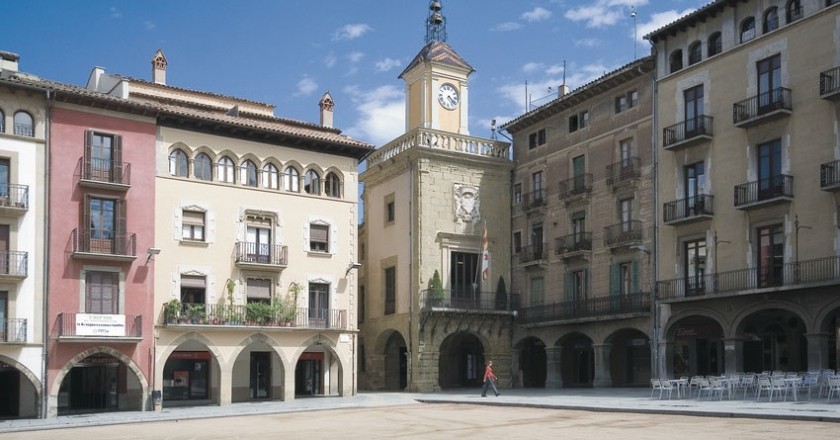
Strolling through the historic center of Vic is a stroll through the past and the history of our country. A signposted route allows to look at thirty buildings, all of historical, architectural or artistic interest, among which the Roman Temple of the s. II; the walls of the s. XIV; the cathedral, where the Romanesque, the Gothic, the Baroque and the Neoclassical converge; Plaza del Mercadal and the city house, among many others!
This marked route can be followed with the texts found in the visitor's guide or by downloading an application through QR codes found during the route. The application also allows you to view the interiors of most buildings with photos and videos.
You accompany us?
0. Plaza Mayor (Mercadal)
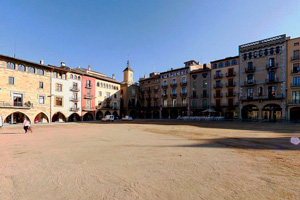 Long before the first house was built, here was an esplanade where a market was held in the open. In the 12th and 13th centuries construction began around; the houses were made with porches to protect themselves from the inclemencies of the time and the normative of the time commanded that the arcs had to be the sufficiently high thing so that a man could happen over a horse. Today the market continues every Tuesday and every Saturday; It is the center of civic life and the setting for all kinds of events and celebrations.
Long before the first house was built, here was an esplanade where a market was held in the open. In the 12th and 13th centuries construction began around; the houses were made with porches to protect themselves from the inclemencies of the time and the normative of the time commanded that the arcs had to be the sufficiently high thing so that a man could happen over a horse. Today the market continues every Tuesday and every Saturday; It is the center of civic life and the setting for all kinds of events and celebrations.
The buildings are from different times and styles, but they present a great harmony as a whole. In a corner, the sculpture dedicated to the Merma marks one of the meeting points: it is dedicated to the most popular member of the family Head of Llupià, the tadpoles of Vic, who accompany the giants of the city during the holidays and are very popular among the little ones The center of the square has never been paved or asphalted and has maintained its essence throughout the centuries, which makes it one of the most unique squares in the country.
1. House of the City
The oldest part of the Town Hall is the building of the XIV century where today is the Tourist Office. La Llotja del Blat was an open space where meat and fish were sold and wheat and flour were weighed; the floor above, there were units for City Council meetings.
With time the building was extended with the purchase of the neighboring houses until obtaining an exit in the place of the Mercadal, as it corresponded to a so representative building for the city.
2. House Cut
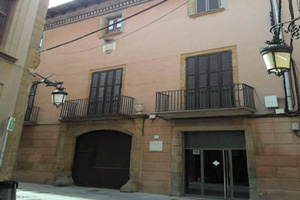 The Cortada house is a typical example of the stately houses of the Baroque era of Vic. Austere on the outside, inside it preserves the original furniture and decoration with mural paintings by Francesc Pla, El Vigatà (1743-1805), considered the Catalan painter most interesting of the last quarter of the eighteenth century. The paintings narrate the adventures of Telemachus, son of Ulysses, and have been kept in very good condition. This house was one of the best in the city.
The Cortada house is a typical example of the stately houses of the Baroque era of Vic. Austere on the outside, inside it preserves the original furniture and decoration with mural paintings by Francesc Pla, El Vigatà (1743-1805), considered the Catalan painter most interesting of the last quarter of the eighteenth century. The paintings narrate the adventures of Telemachus, son of Ulysses, and have been kept in very good condition. This house was one of the best in the city.
3. Birth house of Sant Miquel dels Sants
Miquel Argemir, known as sant Miquel dels Sants since he was canonized by the Catholic Church in 1862, was born in this house in 1591 and died in Valladolid in 1625. That is why in these two cities is where today there is a great majority of men who carry This name and they celebrate the name day on July 5. On this date Vic also celebrates the festival, since the patron saint is Miquel dels Sants.
4. The Old Seminary and the Church of Sant Just
Here they studied, among many others, the f ilòsof of Vic Jaume Balmes, the Folgueroles poet Jacint Verdaguer or Sant Antoni M. Claret, who founded the Claretian congregation in one of the cells.
5. Fontcoberta House
In this manor house there was born the writer M. Àngels Anglada (1930-99). The corners of the house, the street and the neighborhood make up the everyday universe of part of his work.
6. Hospital of the Holy Cross
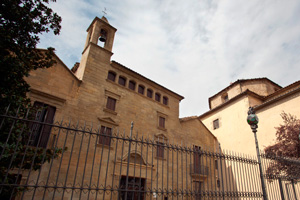 In medieval times hospitals were built outside the walled enclosures, but near one of the access doors to the city. This was done in 1348 when the merchant Vic Ramon de Terrades left his property to the city to make a hospital for the sick, pedestrians and abandoned children.
In medieval times hospitals were built outside the walled enclosures, but near one of the access doors to the city. This was done in 1348 when the merchant Vic Ramon de Terrades left his property to the city to make a hospital for the sick, pedestrians and abandoned children.
7. Church and Convent of Sant Jaume
The Dominicans occupied the convent until 1835, which was assigned to a charity house and is currently the headquarters of the Vic Art School.
8. House of the Claretian Missionaries and Church of San Antonio M. Claret
The condition of episcopal headquarters and the influence of ecclesiastical institutions favored the presence of convents and congregations, many founded in Vic. The house of the Claretian missionaries and the church of San Antonio M. Claret (1807-1870), built in the middle of the twentieth century, is a clear example.
9. Casa Bayés
It is the family home of the Bayés family of doctors and the illustrator Pilarín. The prestigious doctor Cándid Bayés promoted the reform of the house of the XV and XVI centuries to install the current office.
10. Bishop Oliba
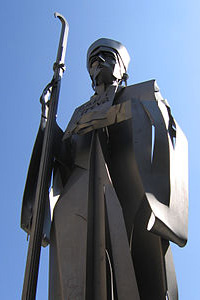 Oliba came from a Catalonian family and, before bishop of Vic, was abbot of Ripoll and Cuixà and founder of the monastery of Montserrat. He had a great influence on the society of the eleventh century, when Catalonia was being structured as a country and Vic was one of the key points.
Oliba came from a Catalonian family and, before bishop of Vic, was abbot of Ripoll and Cuixà and founder of the monastery of Montserrat. He had a great influence on the society of the eleventh century, when Catalonia was being structured as a country and Vic was one of the key points.
11. The Cathedral
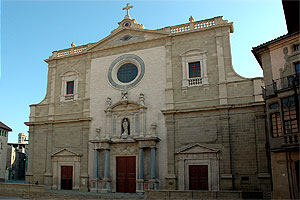 Of the cathedral that the bishop Oliba built in the eleventh century, there are the bell tower, the crypt and the remains of the church of Santa María, marked on the pavement of the cathedral square. The bell tower is the highest in Catalonia Romanesque style and one of the emblems of Vic.
Of the cathedral that the bishop Oliba built in the eleventh century, there are the bell tower, the crypt and the remains of the church of Santa María, marked on the pavement of the cathedral square. The bell tower is the highest in Catalonia Romanesque style and one of the emblems of Vic.
With the passage of time, this cathedral was enlarged and modified several times until the eighteenth century the great neoclassical temple was built. At the beginning of the 20th century, José María Sert was commissioned by Bishop Torras i Bages to decorate the interior of the cathedral.
12. Episcopal Palace
The condition of episcopal seat since the Visigothic period has marked the cultural and religious character of the city throughout the centuries; the boundaries of the bishopric of Vic still include several regions of Catalonia. The origins of the episcopal palace, where the bishop is still residing, date back to the 12th century.
13. Queralt Bridge
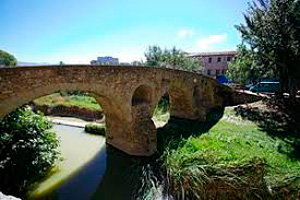 Romanesque style, built in the eleventh century, gave access to the portal of the wall from which the name came. Until 1274 to enter Vic, coming from Barcelona, had to go through this bridge.
Romanesque style, built in the eleventh century, gave access to the portal of the wall from which the name came. Until 1274 to enter Vic, coming from Barcelona, had to go through this bridge.
From then on the king turned the road to Barcelona west and the new road entered Vic through San Pedro street and the Malloles portal, after saving the river by the Gothic bridge of Remedio.
14. Tanneries
From the bridge of Queralt you can see the quarter of the tanneries. On the left bank, looking down the river, you can see the workshops where the finishing of the skins and the dryers to the upper floors were carried out. The leather industry is the most traditional of Vic and has survived until very recently, although in other locations.
15. The Hostelry
From the Romanesque period, this space, linked to the cathedral, had direct access to the cloister, and was the first charitable and hospitable institution in Vic. It was used to welcome pilgrims and pedestrians without resources to the city.
16. The Church of the Dolors
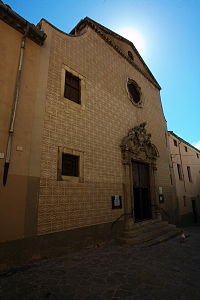 Since 1750 the Congregation dels Dolors organizes every Sunday of Ramos the procession of the armed that takes place in an impressive silence through the streets of the city.
Since 1750 the Congregation dels Dolors organizes every Sunday of Ramos the procession of the armed that takes place in an impressive silence through the streets of the city.
17. The Episcopal Museum
The Episcopal Museum of Vic was inaugurated in 1891, thanks to the efforts of a group of Vic intellectuals and clerics from the Renaissance period, who contributed to the recovery of the Catalan artistic heritage. It conserves a fund of exceptional value, integrated by more than 29,000 pieces, and is declared a museum of national interest. It shows one of the best collections in Europe of medieval art with masterpieces of painting and sculpture of Romanesque and Catalan Gothic.
18. Jewish Quarter
In this place, between the Plaza de Malla and the street of En Guiu, is where the Jewish quarter of Vic was located.
At the end of the thirteenth century, in these and other nearby streets, which today have disappeared, some Jewish families settled down . It is known that there was a synagogue and a school and that they had a very intense activity as providers, although they never formed a strong community.
19. Church of Piety
In the Middle Ages, this square was a citizen center of maximum importance and significance through which passed the division of the episcopal party and the count game. There was the center of the jurisdiction of the Montcada who ruled from the castle, and became a weekly market documented from the tenth century. In the seventeenth century was built the church of the Pieta that occupied much of the space.
20. Roman Temple and remains of the Castillo de los Montcada
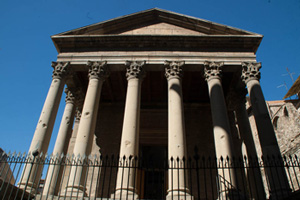 The Temple is the only building that has been recovered from the city of Auso, as it was called Vic in Roman times. It was built in the 1st century AD in one of the highest places of the city and oriented towards the east, following the norms of the time.
The Temple is the only building that has been recovered from the city of Auso, as it was called Vic in Roman times. It was built in the 1st century AD in one of the highest places of the city and oriented towards the east, following the norms of the time.
It was consecrated to the cult of the emperor. Throughout history, the site has maintained a sacred component related to power and is one of the three points from which the city expanded.
21. Walls of Pere III
In the fourteenth century, King Peter the Ceremonious ordered to build, for reasons of defense, the walls that bear his name. It was basically to reinforce the previous ones, from the 12th century, which followed the same route. The walls had forty towers and seven portals, the main one, the portal of Queralt, linked to the bridge of the same name, which is in the only stretch of wall that has been preserved.
22. Church and Convent of Santa Teresa
This baroque ensemble was built in the mid-seventeenth century thanks to a testamentary legacy. It belongs to the order founded by Saint Teresa of Jesus and today the Discalced Carmelites continue to make a life of closure.
23. Set of stately homes of the Baroque period
The baroque coincided with a time of great growth. Vic expanded outside walls and, in addition to churches and convents, between the seventeenth and eighteenth centuries the houses of many wealthy rural owners who wanted to settle in the city were built. The set of houses on Dues Soles Street is a good example.
24. The Student of Vic
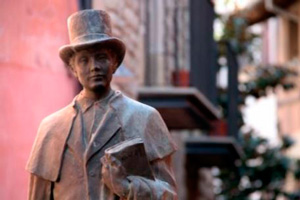 The tradition of higher education in Vic dates back to the Medieval Cathedral School, continues with the Literary University in modern times, with the Tridentine Seminary in the 18th and 19th centuries and with the current University of Vic.
The tradition of higher education in Vic dates back to the Medieval Cathedral School, continues with the Literary University in modern times, with the Tridentine Seminary in the 18th and 19th centuries and with the current University of Vic.
25. Casa Bojons
The Baroque house Bojons houses the room where Jaume Balmes died (1810 - 1848), now converted into a small museum dedicated to his life and work. The priest and philosopher of Vic, Jaume Balmes, participated actively in Spanish politics and was recognized as one of the leading Catholic thinkers of the nineteenth century.
26. Masferrer House
From literary gatherings that the students did in summer in this house, he left the Esbart de Vic, a literary association where Jacint Verdaguer (1845 - 1902), the great poet of Folgueroles who formed intelligent lectualment in Vic, stood out.
27. Plaza del Canonge Collell
The shopping center of Vic occupies a large area around the Plaza Mayor and the Calle de los Plateros, it is a bit the heart. Surprising for the variety and quality of the stores that attract customers from beyond the Osona region. We can find all kinds, including the deli where you can buy the famous Vic sausage.
28. House of Ramon Sala and Saçala
Here lived the veguer Ramon Sala and Saçala at the end of the seventeenth century , famous for its fight against the French at a time marked by the War of the Reapers.
29. Convent of the Sagramentaries
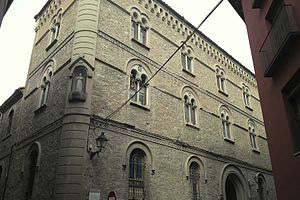 This is one of the two cloistered convents that still remain in the city. One of the functions they have is the preparation of bread for the Eucharist.
This is one of the two cloistered convents that still remain in the city. One of the functions they have is the preparation of bread for the Eucharist.
30. Church of San Felipe
Built in the Baroque era, it shows the restoration of the altarpiece that was destroyed in 1936. In a city with more than thirty churches of all types, this church is the one that chooses the protagonist of the novel Laura to the city of the Saints ( 1931) as a refuge for your prayers.
Consult the entire route, with the descriptions and QR codes in the following link.
What to do
MEV, Museu d'Art Medieval
VicConferences, guided tours, thematic tours, workshops, courses... Discover the permanent collections and…
Federació Pessebres Vivents de Catalunya
Tona (a 9.1 Km)The Federation of Living Nativity Scenes of Catalonia is a non-profit cultural…
Where to eat
Restaurant Dachs
Les Llosses (a 27.3 Km)Restaurant Dachs offers versatile spaces for celebrations in Les Llosses, with rustic…
La Calma, el Bellver
Tagamanent (a 19.6 Km)At the Masía Restaurante El Bellver, from 1:00 p.m. to 3:30 p.m.,…
Braseria Les Comes
L’Esquirol (a 16.5 Km)Located on the premises of the Anigami Adventure Park, they offer menus…
Where to sleep
Càmping El Pont de Barcelona
Vilanova de Sau (a 12.1 Km)The El Pont campsite is located in the heart of the Guilleries…
Casa de colònies Els Porxos, Fundesplai
Vilanova de Sau (a 12.4 Km)Els Porxos is located in the Vilanova de Sau municipality. It is…
Casa de colònies La Cinglera, Fundesplai
Vilanova de Sau (a 12.4 Km)La Cinglera is located in the Vilanova de Sau municipality. It is…

